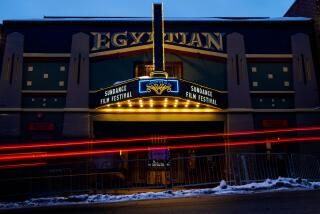Hollywoodâs âAâ Ticket : Overflow Crowds for Biggest Year of Sundance Festival
PARK CITY, Utah â Donât worry; success hasnât squashed the Sundance Film Festival, but that hasnât stopped people from talking.
The early word on everybodyâs lips at this yearâs premiere showcase for American independent films was not about what films were hot but how many people were trying to get into those that were. Despite some of the heaviest snowfall in years, the festival reported a thousand calls about ticket packages after they were sold out, local innkeepers noted literally hundreds of requests for rooms long since taken, and sentiments such as âIâve been fighting, kicking and screaming for ticketsâ and âI got in, but people out there hate meâ were heard, and not infrequently.
Yet this is the biggest festival ever, with 84 features scheduled, 32 in either the dramatic or documentary competition (for which tickets were scarce) and the rest in various sidebar events (for which they often were not). The most popular films have been screened up to six times, including showings in the just-opened Carl Winter Theatre, a newly renovated high school auditorium that seats 500. Still, the perception of overflow remains, and Geoffrey Gilmore, the festivalâs programming director, acknowledges that âmanaging success is something we have to deal with.
âA lot of people are showing up without tickets and theyâre upset when we canât sell them something,â Gilmore adds. âWould you show up at a sold-out play without buying a ticket? Yet people come down here and say, âI canât get in.â They made no arrangements.â
Finally, though, people who complain about Sundance being not what it used to be are like the people who tell you Paris is all used up. Despite all the tumult, or maybe because of it, this remains, for several good reasons, the most exciting of domestic film festivals.
Sundanceâs vitality is a reflection of the continuing strength of the independent film movement, still the creatively healthiest sector of the American film scene. The people who come here, both as competitors and audience, are those who almost literally burn to get their films made, who talk about overcoming the difficulties of their invariably cash-poor productions with the kind of messianic zeal that is more often the exception than the rule in main-street Hollywood. For these people, simply getting a film into Sundance is as close to an Oscar as they may ever get.
For instance, Michael Steinberg, who co-directed last yearâs âThe Water-dance,â planned the shooting schedule for his current âBodies, Rest & Motionâ with a Park City debut in mind. He and his crew worked close to round-the-clock for days to finish it last Wednesday, put it on a plane on Thursday and get it here barely in time for Fridayâs first screening. Victor Nunez went him one better: He cast his âRuby In Paradiseâ during and just after last yearâs festival, the better to take advantage of the spotlight it invariably shines on independent features.
Though the dramatic competition has traditionally been Sundanceâs strong point, this year more people are talking about the documentaries, everything from âRoad Scholar,â in which National Public Radio superstar Andre Codrescu puts the pedal to the metal, to the out-of-competition âTwist,â an energetic look not only at the dance but also at its lively predecessors such as the Lindy Hop and the jitterbug. Much stronger, and one of the most impressive films at the festival is âSilverlake Life: The View From Here.â When L.A. filmmaker Tom Joslin and his lover, Mark Massi, discovered they both had AIDS, they chose to use video to record the course of the disease. The result is devastating, an intimate look not only at deterioration and death but also at a loving relationship of 22 years.
Director Peter Friedman, a friend of both men who finished âSilverlake Lifeâ after they died, says he made the film not only to âmake AIDS a little bit more real for those who havenât had to deal with itâ but also to show that âdepth and substance can exist in a gay relationship.â The result is funny and tender at times, almost impossible to sit through at others and always indelible.
On the dramatic side, a lot of interest has been generated by out-of-competition films such as a new version of Kafkaâs âThe Trial,â starring Anthony Hopkins and Kyle MacLachlan, and Sam Shephardâs upcoming âSilent Tongue.â Among the competition films, âBodies, Rest & Motionâ was one of the most highly anticipated. Starring Phoebe Cates, Bridget Fonda, Tim Roth and Eric Stoltz, it focuses on self-obsessed junior adults, aimless men and the women who fall for them. Oneâs tolerance for this well-acted film depends on how indulgent you feel toward these feckless folks.
No matter what is shown during the rest of the festival, it is doubtful that any film will be as much uncomplicated fun as the delirious âDragon Inn,â an out-of-competition film from the Hong Kong factory of producer Tsui Hark.
A giddy extravaganza set during the Ming Dynasty and centering on the rivalry between two female martial arts wizards, it features enough killer chopsticks, evil eunuchs and dizzying acrobatics to delight the palate of even the most jaded of moviegoers. And it wasnât even sold out.
More to Read
The biggest entertainment stories
Get our big stories about Hollywood, film, television, music, arts, culture and more right in your inbox as soon as they publish.
You may occasionally receive promotional content from the Los Angeles Times.











